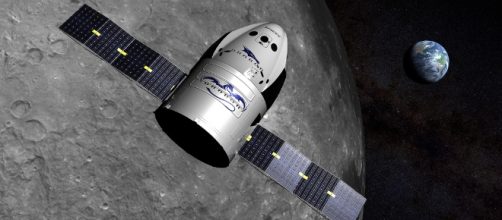SpaceX’s Elon Musk has been quite talkative about his plans to colonize Mars, even though his nearer term scheme to land a Dragon on the Red Planet’s surface has been postponed indefinitely. However, many people may remember that Musk announced that he had a couple of paying customers willing to fly around the moon in a specially outfitted Dragon spacecraft launched by a Falcon Heavy. Space Daily asks, whatever happened to that idea? Musk has not mentioned it since February.
Circumnavigating the moon in 2018
The plan, as articulated by Musk, was to send two paying customers in the Dragon on a free return trajectory around the moon.
The spaceship would launch on the Falcon Heavy, blast out of low Earth Orbit, travel the three day trip to the moon, loop around the far side of Earth’s nearest neighbor, and then return to splash down back on Earth a couple or so days later. The first people to fly beyond low Earth orbit since 1972 would be greeted as heroes.
What has to happen first?
Of course, the first Falcon Heavy has to make a successful launch first. The first flight is scheduled for November 2017. The first crewed Dragon is due to fly to the International Space Station sometime in the spring or summer of 2018. Most analysts think that Musk should send an uncrewed Dragon around the moon first as a test before sending one with passengers.
The upshot is that a 2018 circumlunar flight is likely a little too ambitious. That is fine as Musk (not unique in aerospace) has been a little too boastful about what he intends to do and when.
The importance of a private circumlunar flight
In the meantime, the Trump administration is quietly formulating a space policy that will pivot NASA away from the Journey to Mars to a near term return to the moon. The reported nominee for the position of NASA Administrator, Rep. Jim Bridenstine, R-Oklahoma, is a warm supporter of both a return to the moon and of commercial space. The official announcement of Bridenstine’s appointment is to occur sometime after Labor Day.
A private circumlunar flight would be a perfect demonstration of the capacity of the commercial sector to be a full partner for a NASA-led to return to the moon.
The lunar effort will still be built around the Orion and the Space Launch System. However, commercial rockets, such as the Falcon Heavy as well as Blue Origin’s upcoming New Glenn and the ULA Vulcan, will have an important role. If the first people to venture beyond low Earth orbit in almost 50 years do so on a commercial rocket, that role will be substantial indeed.


